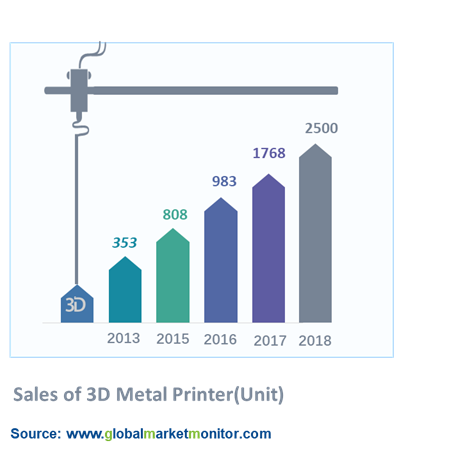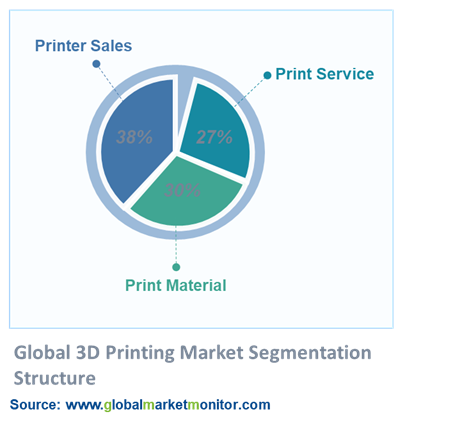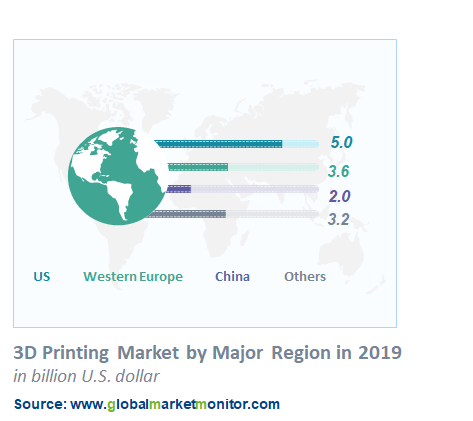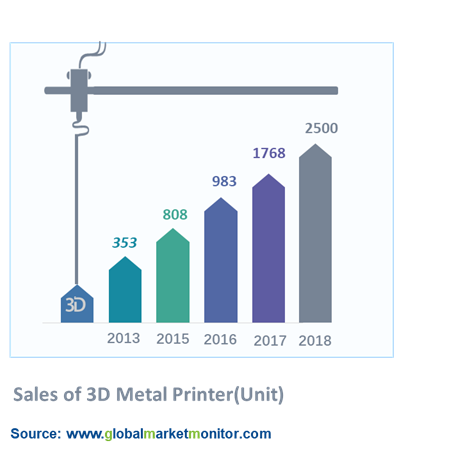The Fourth Industrial Revolution was rapidly unfolding on a global scale, in which various advanced technologies flourished and complemented each other. 3D printing technology is one of the representative technologies of the fourth industrial revolution. Much wealth created by 3D printing technology in various industries is enough to attract the attention of manufacturers and investors.
In 2018, there were 177 companies in the world with independent R&D and production capabilities for 3D printing, in which most companies are paying more attention to the system and comprehensiveness of market development, starting from all aspects of 3D printer production to pursue more efficient and mature 3D printing technology. It has a significant effect on promoting the overall development of the 3D printing industry. Relevant data shows that the global 3D printing market has grown from 3 billion US dollars in 2013 to 13 billion US dollars in 2019, with a compound annual growth rate of 23%.

3D Printer Sales and Printing Materials Sales Account for the Industry's Main Source of Income
From the perspective of the income sources of the 3D printing industry, it mainly comes from 3D printer sales income, printing material sales income, and printing service income. Among them, the sales income of 3D printers and printing material sales account for nearly 70% of the overall industry. The overall scale of the global 3D printing market in 2019 was 13 billion US dollars, of which 5.3 billion US dollars came from printer sales and 4.2 billion US dollars came from sales of printing materials, accounting for 38.13% and 30.22% respectively.

Enquire before purchasing this report-
https://www.globalmarketmonitor.com/request.php?type=3&rid=589760
The United States Has Always Been the Largest Consumer Market
The United States is the origin of the 3D printing technology, which has core industrial technology and was the first to support industrial development from the national strategic level. It is committed to the social application of low-cost 3D printing equipment and the application of metal parts direct manufacturing technology in the industry, making various industries have contacted and integrated 3D printing earlier, and 3D printing has rapidly penetrated the US market. One of the reasons why the US can become the world's largest consumer market for 3D printing and continue to lead the global 3D printing market is that the US has never stopped in technological research and development. The size of the 3D printing market in the US in 2019 is 5 billion US dollars, followed by Western Europe and China, with 3 billion US dollars and 2 billion US dollars respectively.

Domestic 3D Printing Started Late, But Progressed Fast
China began to invest in 3D printing molding equipment, software, and materials since the early 1990s, but the industrialization development was relatively difficult and made breakthroughs after years of hard work. The early stage of domestic 3D printing industrialization is mainly about technological breakthroughs and the formulation of industrial standards, in which it produced a large number of related patents, and core capabilities such as printing materials, equipment parts, and industrial standards were rapidly cultivated and developed; the second stage was industrialization. In 2017, it was proposed in the work plan issued by the Ministry of Science and Technology to make 3D printing technology a key development project. Since then, domestic companies involved in 3D printing have emerged in endlessly. In 2018, there were about 90 companies involved in 3D printing. At present, mainstream metal 3D printing technology in China and equipment manufacturers such as SLM have reached an advanced level around the world.
In Terms of Printing Materials, Metal 3D Printing Materials Have the Greatest Development Potential
Looking at the composition of 3D printing materials, the proportion of metal consumables is slightly lower than the most widely used plastic. Metal printing is currently in the industry expansion stage, in which the growth of equipment is ahead of that of materials. Non-metal 3D printing usually uses plastics and resin materials, and metal 3D printing usually uses various alloy powders and wires. Compared with the traditional manufacturing model, the advantages of non-metal 3D printing are mainly No mold required and customizable printing, which is mainly used for the production of samples and molds due to the limitation of material properties; while metal 3D not only has the above advantages but also improves the printing efficiency and printing quality compared to traditional metal processing technology, even completes the printing of high-complexity and high-precision parts that cannot be manufactured by traditional technology. It can be seen that 3D metal printing will not replace traditional printing, but a strong supplement to traditional printing, which has greater development potential.
Enquire before purchasing this report-
https://www.globalmarketmonitor.com/request.php?type=3&rid=590963
The market survey results from 2017 to 2018 can support the above view. Last year, a French company surveyed of nearly 1,000 companies applying 3D printing around the world. The survey results showed that the usage rate of the plastic with the highest usage rate dropped from 65% in 2017 to 42% in 2018, and other materials also experienced the same decline. The utilization rate of resin declined by 6 percentage points, ceramics declined by 3 percentage points, and sandstone declined by 5 percentage points. However, only metal materials bucked the trend. The utilization rate rose from 28% in 2017 to 2018. 36%. Although the growth rate is relatively small, this growth trend can be regarded as the toughness and potential of the development of the metal materials industry.

Domestic Companies of 3D Printing Metal Material Are Growing Rapidly, But the Products Are Concentrated in the Middle and Low-End Grade
Currently, nearly 100 materials in China have achieved technological breakthroughs, including titanium alloys, high-strength steels, nylon powders, and carbon fiber composite materials. The types and quality of products presented are increasing, which can meet the additive manufacturing needs of domestic equipment. However, in the field of high-performance metal powders, domestic materials still show obvious shortcomings, which are mainly reflected in purity, uniformity, and oxygen content. Most of the foreign suppliers of 3D printing consumables with excellent performance were born in the last century, which has accumulated a lot of experience in powder metallurgy and metal printing equipment for many years. Typical representatives are EOS, TLS in Germany, and Sweden. Arcam, Hogans, Sanvik, and Solay in Belgium. However, there is no such good foundation in China as foreign companies. Most domestic companies involved in high-quality metal powder businesses only have developed for less than 20 years, with less technology accumulation. And with the continuous R&D of domestic enterprises and the increasing globalization, domestic enterprises have developed rapidly, mainly represented by AMC Powders, Falcon, and Bright Laser. In the future, under the environment of continuous advancement of metal 3D printing industrialization, metal powder is a strong market, and the demand for it from the outside world will increase. We believe that the shortcomings of domestic high-end metal printing materials are expected to make up for rapidly.
LEARN MORE:
3D Printing Materials
https://www.globalmarketmonitor.com/reports/589760-3d-printing-materials-market-report.html
3D Printing Plastic
https://www.globalmarketmonitor.com/reports/590963-3d-printing-plastic-market-report.html
3D Printing for Healthcare
https://www.globalmarketmonitor.com/reports/592031-3d-printing-for-healthcare-market-report.html
We provide more professional and intelligent market reports to complement your business decisions.